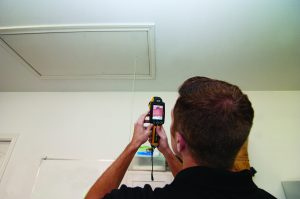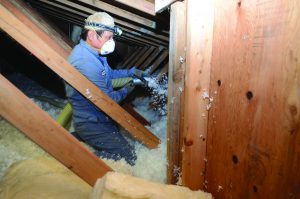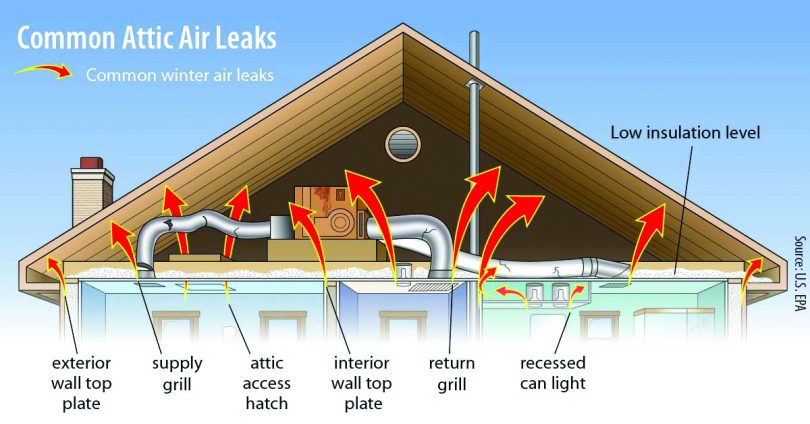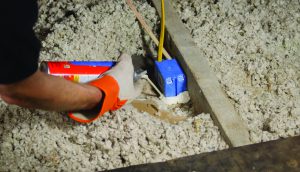By Patrick Keegan and Amy Wheeless
When you venture outdoors in the winter without a hat and coat, you obviously will feel much colder, much faster. Similarly, when your home is not properly sealed and insulated, cold air sneaks in and heat escapes, making your heating system work harder and your home less comfortable. Sealing and insulating your home to efficient levels can cut your heating and cooling costs by an average of 15 percent, and sometimes much more—all while making you more comfortable in your home.
Your attic is one of the first places you should consider insulating since it is usually accessible and easy to inspect for air leaks and insulation levels. Additionally, most homes do not have enough attic insulation. Insulation standards for new homes increased in 2012, and many homes built before then do not have the current recommended amount of attic insulation.
Insulation is graded by its “R-value” – the higher the R-value, the greater the insulating power. If you live in a mild climate, your attic should have a minimum grade of R-38, or about 13-14 inches of insulation. If you live in a colder climate, R-49 is the minimum recommendation, or about 16-18 inches of insulation. More may be needed depending on your home and exact climate.

An auditor inspects an attic hatch with an infrared camera. Photo Credit: United Cooperative Services (TX)
How can you tell if your attic is lacking in insulation? As a general rule, if you go into your attic and can see the ceiling joists on the attic floor, there is not enough insulation. Hiring a trained energy auditor is the best way to diagnose shortcomings with insulation or any other energy-related issue. Check with your electric co-op to see if they offer energy audits or can refer you to a local energy auditor. Your co-op may also offer a rebate for adding attic insulation.
Once you determine that you need more insulation in your attic, there are a few things you can do before laying down additional insulation:
- If you currently store items like holiday decorations in your attic, consider another suitable storage location in your home. If you must use your attic for storage, build a platform high enough to allow installation of the recommended level of insulation.
- If you live in an older home, you should check your attic’s electric wiring. Is the insulation around the wires degrading? Do you have knob and tube wiring? In either case, you will likely need to replace the wiring before proceeding.
You will then need to decide who will do the insulation work. If a “DIY” project interests you, you’ll need to do some homework. Installing insulation is messy, potentially dangerous and requires special equipment. Fortunately, there are many experienced insulation contractors. You should discuss a few things with the contractor before you agree to hire them:
- Be sure that you or your contractor seals any air leaks, such as around furnace flues and around any exposed air ducts in the attic. Air leaks can bring warm, moist air from your home into the attic, which can reduce the insulation value and create mold.
- Pay particular attention to your attic door or hatch. This entry point is a significant contributor to heat loss and heat gain in the home.
- If you have existing attic insulation, it is usually not necessary to remove it unless it is wet, moldy or contains animal waste.
- Make sure there is sufficient ventilation in the attic. Warmth and moisture can build up in an improperly ventilated attic, which can lead to roof problems, such as roof rot or ice dams.

Blown-in insulation can fill spaces better than batt insulation, but requires special equipment. Photo Credit: Weatherization Assistance Project
There are two types of insulation that you could place on your attic floor: batt/roll or blown-in/loose fill. Blown-in insulation requires special equipment to install, but it fills the space better than batt insulation, which can leave gaps and voids without careful cutting and placement around ceiling joists, vents and other attic impediments.
Insulation is most commonly made from fiberglass, cellulose or mineral wool. Many energy advisors recommend blown-in cellulose insulation due to its superior coverage, high R-value and air sealing abilities; blown-in cellulose insulation is treated with boric acid, which acts as a fire retardant and insect repellent.
Before you get started, consult with your local energy auditor or insulation contractor. They can help determine what type and material of insulation will work best in your home.
This column was co-written by Pat Keegan and Amy Wheeless of Collaborative Efficiency.


